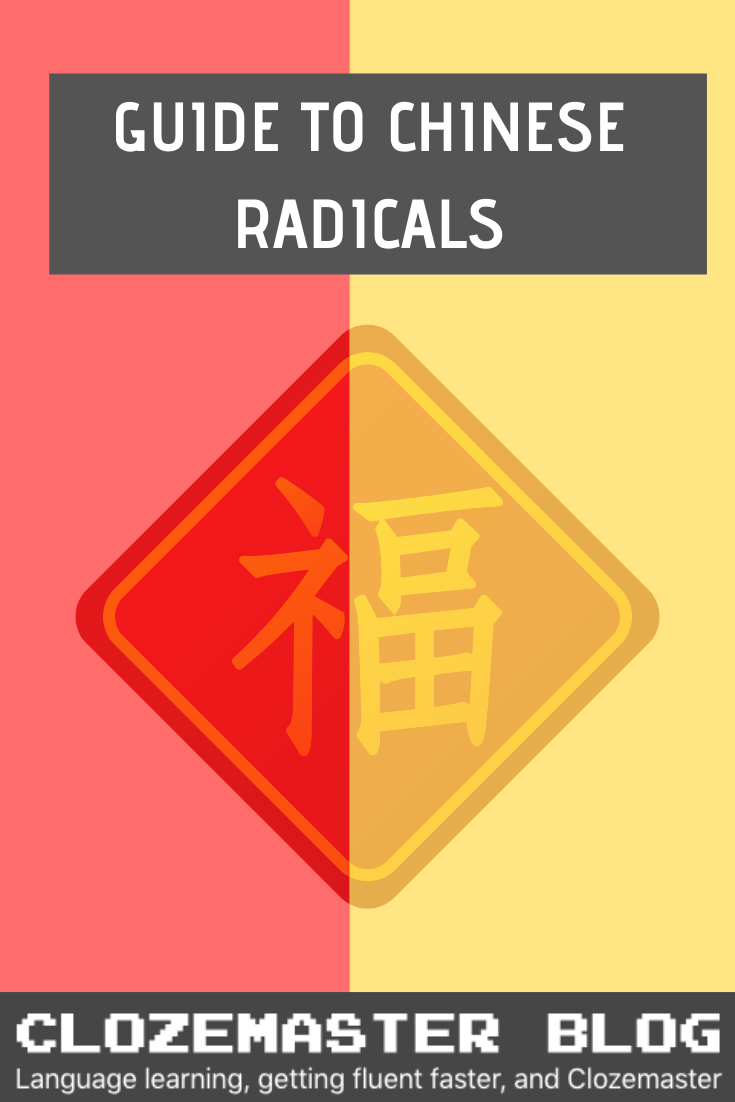
One of the most exciting aspects of learning Chinese for me is learning how to read and write characters. The logic, history, and complexity behind them is just fascinating. But without any way to break them down, they quickly become an overwhelming, seemingly impossible task. That’s where Chinese radicals come in – a way to make sense of the chaotic world of Chinese characters.
What are Chinese radicals?
All Chinese characters are made up of a finite number of components which are put together in different orders and different combinations.
Chinese radicals are what we could think of as the base component of each character. It is usually the leftmost part of the character. Chinese radicals can hold information about the character meaning and/or sound. There are around 200 radicals in Chinese, and they are used to index and categorize characters.
Do you really need to know Chinese radicals?
Chinese radicals have many important uses. Chinese dictionaries are traditionally sorted by the radicals – first by the number of strokes in the radical, then the number of strokes in the characters. So, back in the day it was very important to understand radicals. Nowadays, with the thousands of different ways to look something up online? Not so much (although looking things up this way can be a good way to get familiar with character components).
So, can we forget about radicals already? Definitely not. Native speakers and successful learners alike use Chinese radicals to master Chinese reading and writing.
Let’s put it this way. If you start learning Chinese characters, and you try to memorise each one individually, you will spend a lot of time on each character, and as a result you will learn fewer characters over more time. When you relate them to one another using radicals, you can learn more characters quickly.
In other words, learning Chinese radicals is a more efficient way to learn Chinese characters.
Things to understand about Chinese radicals
- There is a radical in every character, even if the radical is the character.
- The same radical can change position in different characters. For example, the radical 火 appears to the left in the character 烤 and at the bottom in the character 照.
- The same radical can change its form in different characters, which is often in accordance with the change in position, as seen in the above example. This also happens with the radical 心, which is squeezed up in the character 忙 and flattened in the character 忘.
- Radicals will sometimes but not always be characters in use on their own, as shown in the table below.
- Radicals will not always be obviously related to the meaning or sound of a character they appear in.
Some examples of Chinese radicals
Most of the main radicals you will come across immediately when you start studying Chinese are listed in this article. This is by no means a complete list. For a full list of Chinese radicals, check this link.
Radicals that appear on the left of the character
| Radical | Radical as character | pinyin | meaning | examples |
| 亻 | 人 | rén | person | 你 you (nǐ) | 他们 (tā.men) |
| 氵 | 水 | shuǐ | water | 河 river (hé) | 洗 wash (xǐ) |
| 日 | 日 | rì | time/day | 时 time (shí) | 早 early ( zǎo) |
| 月 | 月 | yué | moon | 服 wear (fú) | 朋友 friend (péng.yǒu) |
| 女 | 女 | nǚ | female | 好 good (hǎo) | 妈妈 Mom (mā.ma) |
| 子 | 子 | zǐ | child | 孩子 child (hǎi.zi) | 孜 diligent (zī) |
| 口 | 口 | kǒu | mouth | 唱 sing(chàng)| 喝 drink (hé) |
| 讠 | 言 | yán | language | 说话 talk (shuō.huà) | 语言 language (yú.yán) |
| 扌 | 手 | shǒu | hand | 推 push (tuī) | 拉 pull (lā) |
| ⻊ | 足 | zú | foot | 踢 kick (tī), | 跑 run (pǎo) |
Radicals that appear elsewhere in the character
| Radical | Radical as character | Pinyin | Basic meaning | Examples | Position in character |
| 火 | 火 | huǒ | fire | 热 hot (rè) | 点 few (diǎn) | below |
| 心/忄 | 心 | xīn | heart | 想 think (xiǎng) | 忘 forget (wàng) | below |
| 艹 | 草 | cǎo | grass | 花 flower (huā) | 菜 grass (cài) | above |
| 宀 | mián | roof | 家 home/family (jiā) | 室 room (shì) | above | |
| 囗 | 囗 | wéi | enclosure | 国 country (guó) | 园 park (yuán) | surrounding |
| 阝 | 邑 | yì | place | 部 part (bù) | 那 that (nà) | right |
| ⻌ | chuò | action | 進 enter (jìn) | 远 far (yuǎn) | left and below | |
| 疒 | nè | illness | 病 sick (bìng) | 通 pain (tóng) | left and above |
How do I find the radical of a Chinese character?
By looking at a character, you should be able to have a good guess at its radical. Some things to keep in mind if you want to find the radical are:
- The radical is generally on the bottom in a vertical character (such as 思 – radical is 心)
- The radical is usually on the left in a horizontal character (such as 什 – radical is 亻)
- If the character has horizontal and vertical components, remeber the radical usually spans the length of the character (such as 没 – radical is 氵- and 愁 – radical is 心)
- If you’re still not sure, many Chinese resources can tell you what the radical is for a given character. For example, you can type or paste in any character here and it will tell you a lot of information about it, including its radical.
How do I use Chinese radicals to learn characters?
As I mentioned at the beginning of this post, using Chinese radicals is probably the most efficient way to learn Chinese characters. But how exactly do you use them?
A good way to do it is learn characters in groups according to their radicals. This can also be a form of topic-learning, since as we’ve seen most radicals denote certain meanings. So for example, you could dedicate a week to mastering each radical. Most good textbooks will have some kind of radical teaching and breakdowns. But if you’re teaching yourself Chinese, you can create your own plan around this. You can use Arch Chinese to find most of the characters associated with each radical.
My suggested plan to learn Chinese radicals
I suggest starting with the Chinese numbers, and then go on to study:
- Week 1: 人 (pronouns, basic greetings)
- Week 2: 子 (education, people)
- Week 3: 宀 (house, family)
- Week 3: 言 (languages)
- Week 4: 囗 (countries)
- Week 5: 阝 (directions)
- Week 6: 辶 (motion)
- Week 7: 疒 (illnesses)
- Week 8: 心 (thoughts and feelings)
Since there are more than 200 radicals, if you take a week for each, it would obviously take you a while to get through all of them. So once you’ve mastered those eight, go to two radicals per week, preferably two related in meaning (like 手 and 足). When you‘ve got a grasp on the basic, most common ones like the ones in this article, you could try going through 3 a week. This might sound like a lot, but the more characters you learn, the easier it becomes to learn new characters.
Hopefully, you now understand a bit more about Chinese radicals and how they work to form Chinese characters. Don’t forget to use Clozemaster to practise using Chinese characters in context!
| Sign up here to start getting fluent with thousands of Chinese sentences at Clozemaster. Clozemaster has been designed to help you learn the language in context by filling in the gaps in authentic sentences. With features such as Grammar Challenges, Cloze-Listening, and Cloze-Reading, the app will let you emphasize all the competencies necessary to become fluent in Chinese.Take your Chinese to the next level. Click here to start practicing with real Chinese sentences! |



What a great content! Too bad it has just the basic radicals 🙁
Thank you, anyway!